The Baltimore City (MD) Fire Department (BCFD) was going through a stagnant time of apparatus purchases and replacements from around 1915 to 1938. The city was not purchasing new apparatus to keep up with the ever-growing call volume and expansion of the city.
Engine 8 finally got a new rig in 1939, while Truck 10 went through a series of refurbs, changes in front-end power units, but keeping the same trailer and aerial device. The department was getting ready to move toward the highest numbers of in-service companies and apparatus serving the city. We will pick up on the history and progression of the department in 1938.
Earlier: Baltimore’s ‘Jobtown’ Fire District Has Storied Past, Part 1
The fleet progressed until the mid-1900s, when the purchase of apparatus was almost nonexistent. Then, in 1938, the department purchased eight new Mack, Seagrave, and American LaFrance engines. They were painted white with the Baltimore red accents.
In the 1950s, the department was going full steam ahead and growing at a great pace. During this time, the department was at the highest number of fire companies in the history of the department with 58 engines, 30 trucks, 12 ambulances, four fireboats, and a single heavy rescue.
The 1970s saw another round of sweeping changes to the department, starting with the largest apparatus purchase to date from Seagrave, consisting of 23 engines and six trucks. The construction of the super houses was completed with the Steadman House, named in honor of Deputy Chief John Steadman, and the Old Town Station.
Also during this time period, the first safety officer position was created and held by Herman Williams, who would later become the first African American fire chief for the department.

1 Engine Co. 8 and Truck Co. 10 headquarters in 1912. (Photos courtesy of BCFD 8X10.)
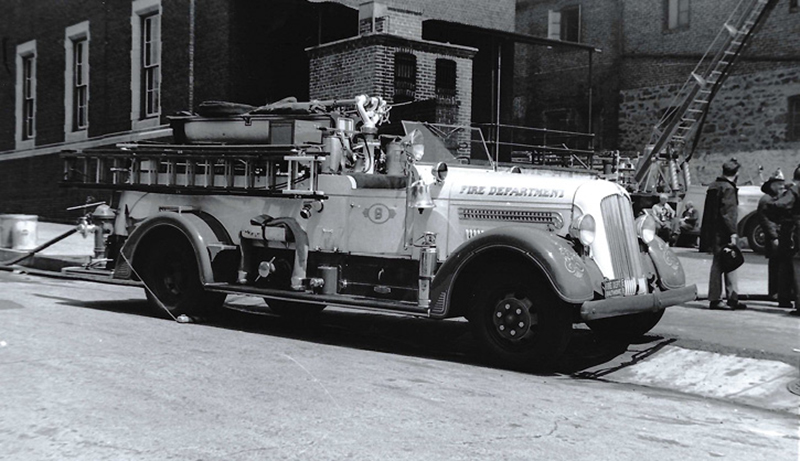
2 A brand new 1939 Seagrave pumper.

3 A brand new 1954 Pirsch pumper.
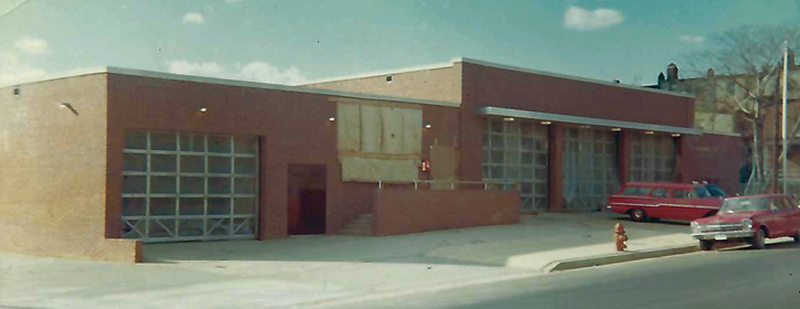
4 A new station on Lafayette Street in 1967.
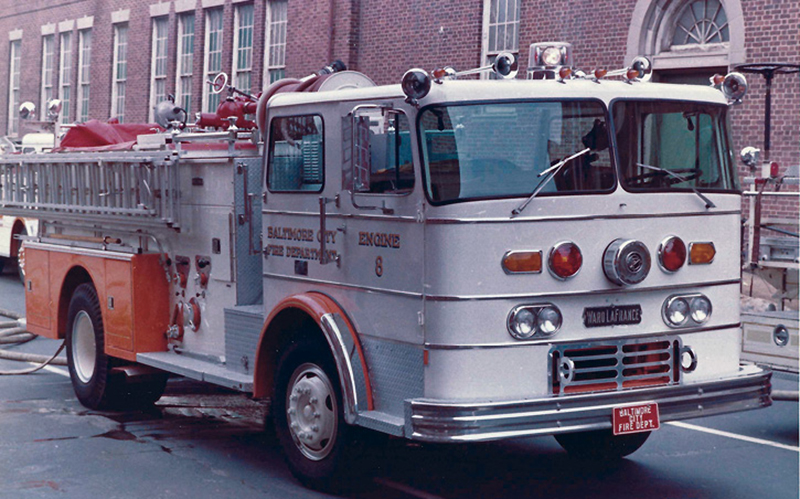
5 A new 1974 Ward LaFrance pumper.
The department kept moving forward through the 1980s, 1990s, and 2000s, working to make the department better and increase service to the citizens. There were certainly some challenges along the way financially and a slow apparatus replacement plan. However, the department has been steadily purchasing new apparatus for the past decade and has switched over to the all-red paint scheme that we see today. It would not, however, break my heart to see the city go back to the Baltimore iconic white with the orange accents. That scheme certainly made for some great-looking rigs.
Let’s take a closer look at the two Jobtown companies and the apparatus used to serve that portion of Baltimore.
In 1912, Engine Company 8 was relocated to the quarters of Truck 10 on Lafayette Street due to the condition of the quarters on Mulberry Street. This station not only served to house Engine Co. 8 and Truck Co. 10 but also served as the horse hospital in the previous years (photo 1).
In 1923, Engine Company 8 was issued a used 1913 American LaFrance 750-gallon-per-minute (gpm) engine. This had a 35-gallon tank, 1,000 feet of 2½-inch hose, and 250 feet of ¾-inch hose.
In 1930, Engine Company 8 receive a used Seagrave engine manufactured in 1919. This rig had a 750-gpm pump with 1,300 feet of 2½-inch hose and 250 feet of ¾-inch hose.
In 1939, the company received a brand-new Seagrave pumper. This engine had a 750-gpm fire pump, 1,300 feet of 2½-inch hose, and 250 feet of ¾-inch hose. The rig had a 200-gallon booster tank and 24-foot and 12-foot ground ladders (photo 2).
In 1954, the engine company on LaFayette Street was issued a brand new Pirsch pumper. This engine had a 1,000-gpm pump, a 200-gallon booster tank, and a mounted monitor pipe (photo 3).
In 1966, the station on LaFayette Street reached the end of its usability as a station. The station was demolished, and a new station was entered into service in 1967, which is the current quarters of Engine 8 and Truck 10 (photo 4).
1974 brought a new era to Engine Co.8 when a new 1974 Ward LaFrance with an enclosed front cab and seating for five was delivered. The engine had a 1,000-gpm pump and a 500-gallon booster tank. Its first diesel-powered engine included a portable monitor pipe, and it was painted in the iconic orange and white paint scheme (photo 5).

6 A new 1990 Sutphen pumper.

7 A new 2003 Pierce pumper.
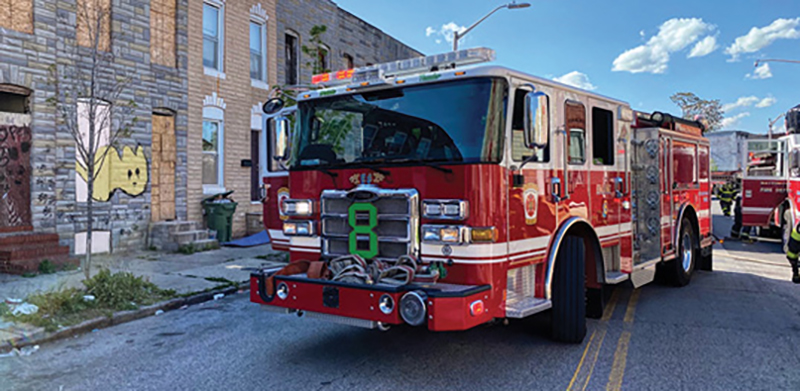
8 A new 2019 Pierce Enforcer pumper.

9 A 1941 tractor-drawn Seagrave aerial.
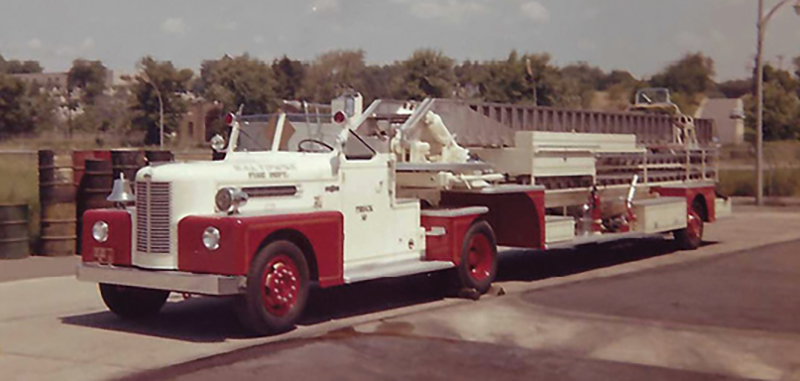
10 A 1957 Pirsch tractor-drawn aerial.
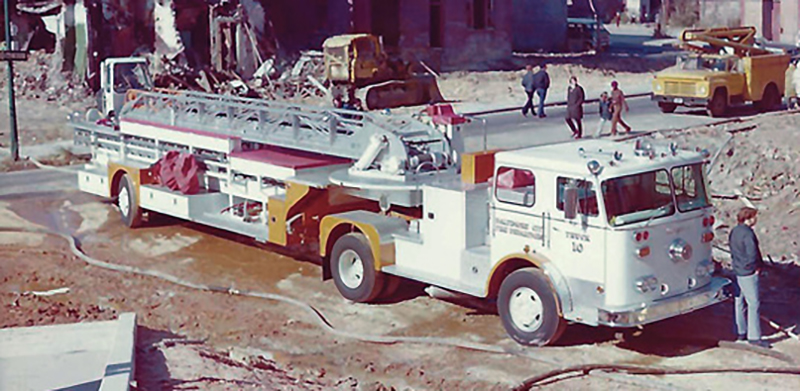
11 A 1974 100-foot Seagrave aerial.
The Ward LaFrance lived a long life as Engine 8 and was replaced with a 1990 Sutphen four-door, enclosed-cab pumper. It had a 1,250-gpm pump and a 500-gallon water tank. The Sutphen was taken out of service in early 2003 and interestingly was relettered Engine 33 to be used in the motion picture Ladder 49 (photo 6).
In 2003, Engine 8 received a new Pierce Enforcer engine now painted with the BCFD red paint scheme. This engine had a 1,250-gpm pump, a 500-gallon water tank, and a 10-gallon foam tank (photo 7).
The current rig being run by Engine 8 is a 2019 Pierce Enforcer. This engine upgraded to a 1,500-gpm pump but still carries a 500-gallon water tank (photo 8).
Truck Company 10
On March 1, 1895, Hook & Ladder Company 10 was organized and placed in quarters on Lafeyette Street. Its initial apparatus assignment was a used Hayes 55-foot aerial, built by the LaFrance Co. in 1888. The rig was formerly assigned to Hook & Ladder Company 6.
Later, in 1895, it received a new ladder truck—a 75-foot Hayes aerial built by the LaFrance Co. This rig was drawn by three horses and the aerial had to be manually raised.
In 1908, the company received another new Hayes aerial truck with a Dahill hoist built by LaFrance Co. This rig was drawn by a three-horse team.
In 1916, the horses were retired from Hook & Ladder Company 10 and the rig was outfitted with a two-wheel Christie.

12 The 1974 Seagrave aerial was repainted at the shop and at the station because of rust problems and was dubbed “the Grey Ghost.”
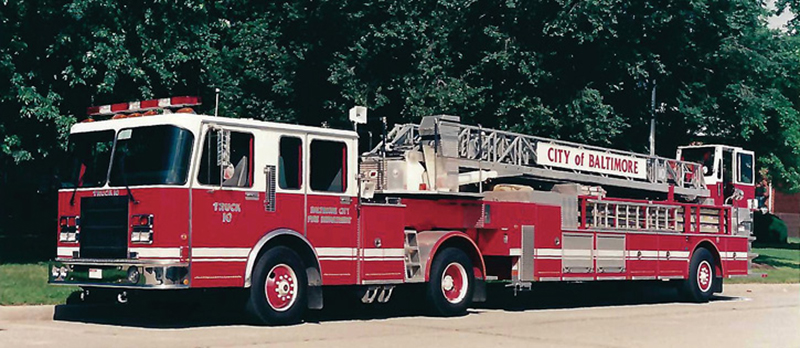
13 A new 1995 Spartan/LTI tractor-drawn aerial.

14 A 2007 Pierce Dash 100-foot tractor-drawn aerial.
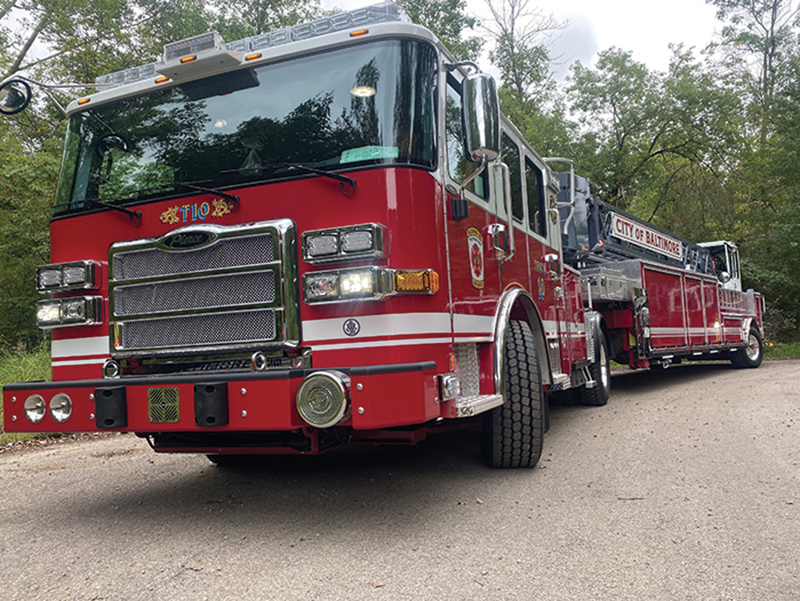
15 A 2020 Pierce Enforcer 100-foot tractor-drawn aerial.
In 1923, the Christie tractor was replaced with a Mack AC tractor still towing the Hayes/Dahill aerial.
In 1939, the rig with the Mack AC tractor went in for some modifications that included new fenders, running boards, and pneumatic tires.
May 22, 1941, gave way to the Mack AC tractor and the Hayes/Dahill ladder, and a trailer was now attached to a Seagrave tractor (photo 9).
On November 8, 1957, Truck Company 10 received a brand new Pirsch tractor-drawn aerial ladder. The rig had a 100-foot steel aerial device that was hydraulically raised and extended. The unit also had a removable tiller seat through the ladder (photo 10).
In 1974, the company was issued a beautiful Seagrave 100-foot aerial with a diesel engine and an enclosed tiller cab. The iconic orange and white paint scheme adorned the rig (photo 11). This same rig had some corrosion issues later in its life and the crews at the station painted the rest of the cab grey to match the areas that had been replaced. This warhorse of a rig was loved by the personnel and they renamed the rig “the Grey Ghost“ (photo 12).
In 1995, the Grey Ghost was retired from Truck 10 and it received a new 1995 Spartan/LTI tractor-drawn aerial. The apparatus had a 100-foot aerial, a diesel engine, and an enclosed four-door tractor and enclosed tiller cab (photo 13).
In the early 2000s, the department started buying Pierce apparatus, and Truck 10 received a 2007 Pierce Dash 100-foot tractor-drawn aerial to replace the Spartan/LTI rig (photo 14).
The current Truck 10 is a 2020 Pierce Enforcer 100-foot tractor-drawn aerial, and it has already worked a number of fires (photo 15).
Author’s note: While compiling the information and photos for this article, I was greatly assisted by a number of people and books to help frame this commentary, including Baltimore City Fire Department 150 Years of Dedicated Service; The Unheralded Heroes, by William Murray; The Rigs of the Unheralded Heroes, by William Murray and William Snyder; Ed Schwartz and his vast collection of Baltimore City Fire Department documents and photos; Kyle Stephens, Truck Company 10, Baltimore City Fire Department; Roger Steger, Engine Company 8, Baltimore City Fire Department; Gus Siegel, Baltimore City Fire Department and Internet resources, including BCFD 8X10; #Jobtown; Facebook; and Instagram.
References
Department, B. C. (2010). 150 years of Dedicated Service. M&T Publishing Company.
Murray, W. (1969). The Unheralded Heros. E. John Schmitz & Sons.
William Snyder, W. M. (1971). The Rigs of Unheralded Heros. E John Schmitz & Sons, Inc.
RICKY RILEY is the president of Traditions Training, LLC. He previously served as the operations chief for Clearwater (FL) Fire & Rescue and as a firefighter for Fairfax County (VA) Fire & Rescue. He also is a firefighter with the Kentland (MD) Volunteer Fire Department and a member of the Fire Apparatus & Emergency Equipment Editorial Advisory Board.

